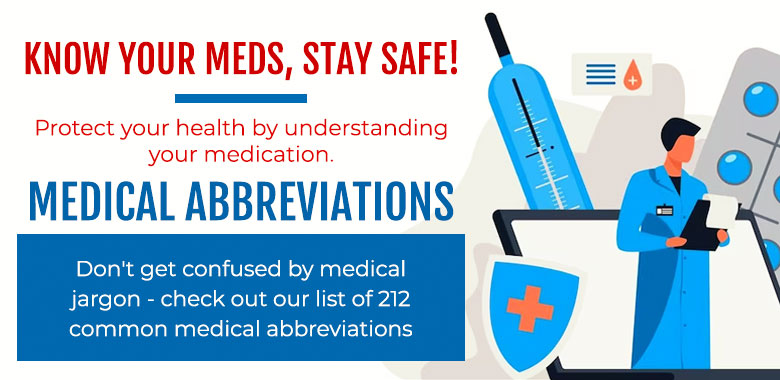
Doctors and healthcare professionals are busy people who need to save time and use space efficiently in their prescriptions. This is where medical abbreviations come in handy. They allow healthcare providers to communicate important information quickly and accurately, particularly in emergencies where every second counts. But as important as these abbreviations are, they can be confusing and even dangerous if not understood by patients. Misinterpreting an abbreviation can lead to serious consequences like taking the wrong medication or dose, or even an overdose.

Some abbreviations have multiple meanings, adding to the potential for confusion. Patients should always ask their healthcare provider to explain any abbreviation they don’t understand to avoid errors. By taking the time to understand these abbreviations, patients can ensure they take their medications correctly and at the right time, leading to better health outcomes.
Stop Feeling Lost and Confused – Read Below to Discover Our Comprehensive List of 212 Common Medical Abbreviations and Unlock the Secrets of Your Prescriptions!
| Abbreviation | Meaning |
|---|---|
| a | Before |
| aa | Of each |
| ac | Before meals |
| ad | Right ear |
| ad lib | As desired |
| AFB | Acid-fast bacillus |
| AG | Silver (argentum) |
| alt. dieb. | Every other day |
| am | Morning |
| AMA | Against medical advice |
| amb | Ambulate, walk |
| ANA | Antinuclear antibody |
| ant | Anterior |
| APAP | Acetaminophen |
| approx. | Approximately |
| aq | Water |
| aq ad iniect. | In water for injection |
| AS | Left ear |
| ASA | Acetylsalicylic acid (Aspirin) |
| AU | Both ears |
| b | Twice |
| BID | Twice a day |
| BM | Bowel movement |
| BP | Blood pressure |
| BRP | Bathroom privileges |
| BUN | Blood urea nitrogen |
| c | With |
| Ca | Calcium |
| cap | Capsule |
| CBC | Complete blood count |
| cc | Cubic centimeter |
| CHF | Congestive heart failure |
| Cl | Chlorine |
| cm | Centimeter |
| CNS | Central nervous system |
| CO2 | Carbon dioxide |
| COPD | Chronic obstructive pulmonary disease |
| CP | Chest pain |
| CPR | Cardiopulmonary resuscitation |
| CSF | Cerebrospinal fluid |
| CVA | Cerebrovascular accident |
| CXR | Chest x-ray |
| d | Day |
| D5W | Dextrose 5% in water |
| D/C or DC | Discontinue |
| DNR | Do not resuscitate |
| dr | Dram |
| DS | Double strength |
| DW | Dextrose in water |
| Dx | Diagnosis |
| ECG or EKG | Electrocardiogram |
| EEG | Electroencephalogram |
| EMG | Electromyogram |
| ER | Emergency room |
| et | And |
| ET | Endotracheal |
| ETOH | Alcohol |
| F | Fahrenheit |
| Fe | Iron |
| FF | Force fluids |
| fl. oz. | Fluid ounce |
| FS | Frozen section |
| Fx | Fracture |
| g | Gram |
| gal | Gallon |
| GC | Gonorrhea |
| GCS | Glasgow Coma Scale |
| GERD | Gastroesophageal reflux disease |
| GI | Gastrointestinal |
| gtt | Drop |
| GU | Genitourinary |
| h | Hour |
| H2O | Water |
| Hb or Hgb | Hemoglobin |
| HCl | Hydrochloric acid |
| HCO3- | Bicarbonate |
| Hct | Hematocrit |
| HEENT | Head, eyes, ears, nose, throat |
| Hgb | Hemoglobin |
| HOB | Head of bed |
| H&P or HPI | History and physical examination |
| HS | At bedtime |
| HTN | Hypertension |
| Hx | History |
Did you know that medical abbreviations can have different meanings based on context? Always check with your healthcare provider to clarify any you don’t understand.
| I&D | Incision and drainage |
| I&O | Intake and output |
| IBW | Ideal body weight |
| ICU | Intensive care unit |
| ID | Intradermal |
| IJ | Internal jugular |
| IM | Intramuscular |
| INH | Isoniazid |
| inj | Injection |
| IO | Intraosseous |
| IPPB | Intermittent positive pressure breathing |
| IUD | Intrauterine device |
| IV | Intravenous |
| K | Potassium |
| KCL | Potassium chloride |
| kg | Kilogram |
| L | Liter |
| L&D | Labor and delivery |
| LEEP | Loop electrosurgical excision procedure |
| LLQ | Left lower quadrant |
| LP | Lumbar puncture |
| LS | Lumbosacral |
| m | Minim |
| mEq | Milliequivalent |
| mg | Milligram |
| mL or ml | Milliliter |
| mm | Millimeter |
| mmHg | Millimeters of mercury |
| mod | Moderate |
| MRSA | Methicillin-resistant Staphylococcus aureus |
| MS | Morphine sulfate |
| mU | Milliunits |
| N/V or N/V/D | Nausea, vomiting, diarrhea |
| Na | Sodium |
| NAD | No acute distress |
| NG or ng | Nasogastric |
| NICU | Neonatal intensive care unit |
| NIDDM | Non-insulin dependent diabetes mellitus |
| NKDA | No known drug allergies |
| NPO | Nothing by mouth |
| NS | Normal saline |
| NTG | Nitroglycerin |
| O&P | Ova and parasites |
| O2 | Oxygen |
| OB | Obstetrics |
| OD | Right eye |
| OS | Left eye |
| OU | Both eyes |
| p | After |
| p.c. or pc | After meals |
| p.o. or po | By mouth |
| p.r.n. or prn | As needed |
| p.t. or pt | Prothrombin time |
| p.v. or pv | Vaginally |
| PALS | Pediatric Advanced Life Support |
| para | Parity |
| PCN | Penicillin |
| PCA | Patient-controlled analgesia |
| PDA | Patent ductus arteriosus |
| PERRLA | Pupils equal, round, reactive to light and accommodation |
| pH | Hydrogen ion concentration |
| PID | Pelvic inflammatory disease |
| PMH | Past medical history |
| p.o. or po | By mouth |
| p.r.n. or prn | As needed |
| post-op | Postoperative |
| pre-op | Preoperative |
| prep | Preparation |
| prn | As needed |
| PT | Physical therapy |
| PT/INR | Prothrombin time/international normalized ratio |
| q | Every |
| q.d. or qd | Daily |
| q.h. or qh | Every hour |
| q.2h or q2h | Every 2 hours |
| q.3h or q3h | Every 3 hours |
| q.4h or q4h | Every 4 hours |
Remember, always follow your healthcare provider’s instructions for taking medications, even if you’re familiar with the abbreviation used. Never hesitate to ask for clarification if you’re unsure.
| q.6h or q6h | Every 6 hours |
| q.8h or q8h | Every 8 hours |
| q.12h or q12h | Every 12 hours |
| q.i.d. or qid | Four times a day |
| q.o.d. or qod | Every other day |
| q.s. or qs | Quantity sufficient |
| q.t. or qt | Quart |
| R | Respiration |
| R/O | Rule out |
| RBC | Red blood cell |
| RDS | Respiratory distress syndrome |
| REM | Rapid eye movement |
| RICE | Rest, ice, compression, elevation |
| RLL | Right lower lobe |
| RLQ | Right lower quadrant |
| ROM | Range of motion |
| ROS | Review of systems |
| RSV | Respiratory syncytial virus |
| Rx | Prescription |
| s | Without |
| SIDS | Sudden infant death syndrome |
| SL | Sublingual |
| SOB | Shortness of breath |
| sq | Subcutaneous |
| SSRI | Selective serotonin reuptake inhibitor |
| stat | Immediately |
| STD | Sexually transmitted disease |
| subq or subcut | Subcutaneous |
| sup or supp | Suppository |
| Sx | Symptoms |
| T | Temperature |
| tab | Tablet |
| TENS | Transcutaneous electrical nerve stimulation |
| tid | Three times a day |
| TPN | Total parenteral nutrition |
| TPR | Temperature, pulse, respiration |
| tr | Treatment |
| TSH | Thyroid-stimulating hormone |
| UA | Urinalysis |
| UGI | Upper gastrointestinal |
| UTI | Urinary tract infection |
| VA | Visual acuity |
| VDRL | Venereal Disease Research Laboratory |
| VS | Vital signs |
| w | With |
| WBC | White blood cell |
| WPW | Wolff-Parkinson-White syndrome |
| wt | Weight |
| y.o. or yo | Years old |
| μg or mcg | Microgram |
| μL or mcL | Microliter |
This is a complete list of commonly used medical abbreviations in prescriptions, along with their meanings. It’s important to note that not all medical abbreviations are appropriate for all medical settings and situations, and their use should always be guided by proper medical knowledge and practice.
Fun fact: The most commonly used medical abbreviation is Rx, which stands for ‘prescription’. How many of these abbreviations did you already know?
In medical charting, the abbreviation “X” is often used to indicate exceptions to defined limits in the patient’s findings or assessment. It signifies that there are abnormal findings within a specific category or parameter. For example, during a cardiac assessment, if a patient has pink, warm, and dry skin, but also has an audible murmur, the presence of the murmur would be indicated by using “X” to represent an exception to the normal cardiac assessment.
This shorthand allows healthcare professionals to quickly signal that there are deviations from expected or defined limits. Following the use of “X,” a focused assessment would typically be documented to provide specific details about the abnormal findings. An alternative to using “X” is using the abbreviations “WNL” (within normal limits) or “WDL” (within defined limits) to denote that the patient’s findings are within the expected range.

By understanding these terms, patients can ensure safe and effective medication use.
It’s important to seek advice from a healthcare provider if patients have questions about their prescription.
Patients should never be afraid to ask their healthcare provider for clarification or further explanation. It’s important to take medication as directed for optimal health outcomes.
Thank you for taking the time to learn about medical abbreviations and other terminology that you may encounter in your prescription. By understanding these terms and asking your healthcare provider for clarification when needed, you can help ensure that you take the correct medication at the right time and dose. Remember, misinterpreting an abbreviation can have serious consequences, so it’s essential to read and follow the instructions carefully.
On this page, we have provided you with a list of 212 commonly used medical abbreviations, along with their meanings and explanations. Keep this reference handy and don’t hesitate to ask your healthcare provider to explain any abbreviation you don’t understand.
Your health and safety are our top priority, and we hope that this page has helped you feel more confident in understanding your prescription instructions. Take care and always stay informed.